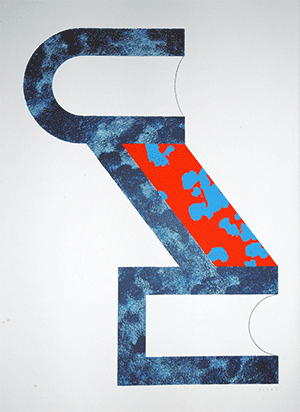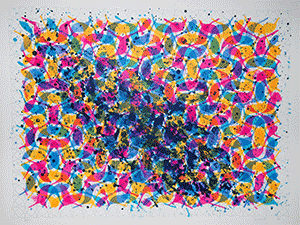キドプレスの歩みPart3
菅井 汲 /堂本 尚郎
2016年8月27日(土)〜 2016年9月25日(日)
月・火・祝日は休廊 最終日は17:00まで
「キドプレスの歩み」展の第三部は、戦後日本の画壇に大きなインパクトを与え、国際的にその名を馳せた菅井汲(1919-1996)と堂本尚郎(1928-2013)を特集します菅井と堂本にとって次々と新境地を開く原動力であった版画制作、そして絵画と版画の影響関係について、1980年代の版画作品を通して再考する展示です。
本展では、木戸均が現代版画工房の刷り師として版画制作に携わった菅井汲の版画《BLEU ブルー》と《DIABLE(ROUGE) 鬼(赤)》の2点(いずれも1985年制作) 堂本尚郎の版画《連鎖反応|水》シリーズより3点(全て1983年制作)の計5点のリトグラフ作品を展示・販売いたします。
菅井汲と堂本尚郎が初めて顔を合わせたのは1952年のパリでした。菅井は1952年6月に33歳の若さで単身フランスに渡ります。
堂本が初めてヨーロッパを訪れた同年、二人はグランド・ショミエールという研究所で出会います。20世紀のパリは、1930 年代のマティスの版画をはじめ、ピカソやシャガールなど数多くの画家が絵画とともに優れたプリントを生み出した版画芸術隆盛期であり、芸術的表現としての版画が一気に花開く時代でした。そのような歴史的背景を持つパリの地で画家として生きた菅井や堂本にとって、版画芸術は特別な意味を持っていたと言えるでしょう。
菅井が最初に発表した版画作品は、1955年の《赤い鬼(悪魔)》というリトグラフです。この作品には日本古来の神話に登場する鬼といった原始的な形象を叙情的に描いた1950年代の初期作品の特色がよく表れています。
本展の出品作である1985年の《DIABLE(ROUGE) 鬼(赤)》は、1955年の《赤い鬼(悪魔)》と比較すると、同じ赤の「鬼」でありながらその構成は大きく異なり、大胆に記号化あるいは単純化された画面が強いインパクトを残します。もう1点の出品作である《BLEU ブルー》(1985年)は、新たな展開として1990年代に次々と制作される《S》のシリーズの予兆とも言えるようなアルファベットの「S」を思わせる形状や幾何学的な構成が見られるという点で、その生涯における様々な変遷を語る上で重要なターニング・ポイントを示す作品として位置づけることができます。
堂本尚郎の《連鎖反応|水》シリーズは、1983年4月12日から4月30日まで南天子画廊で開催された堂本尚郎「連鎖反応|水」展で発表されたアクリル絵具を用いて描いた一連の作品と同時期に共通のコンセプトで制作されています。
中原佑介氏は、当時の堂本尚郎の作品の変化について、次のような興味深い指摘をしています。
「堂本にとっては、画面と水面の対応をより緊密にしようとすることのあらわれであろう。それは画面からイリュージョンとしての奥ゆきを消去し、表面としての画面によってすべてをあらわそうということでもある。アクリル絵具によって物理的に波打った紙面をそのまま作品とするのも、それに根ざしている。描写としての絵画から反描写的作品へと、堂本の作品はその根本のところで、今性格をはっきりと際立たせつつあるように思われる。」
中原佑介「波うつ絵画へ」南天子画廊展覧会カタログ『HISAO DOMOTO 1983』(出版:南<br/>天子画廊、1983年)より引用。
このように「描写としての絵画から反描写的作品へと」変化していく上で、版画制作の版を重ねていくプロセスは作家自身が無意識にたぐりよせていく未知の新しい表現の方向性を再認識する場として、絵画と表裏一体の表現であったと言えるかもしれません。
菅井汲と堂本尚郎がそれぞれ模索し続けた表現の新たな一面を浮かび上がらせる1980年代の版画作品をこの機会にぜひご高覧ください。
For Part III of "The Kido Press Story," Gallery KIDO Press is holding a special exhibition of works by Kumi Sugai (1919 - 1996) and Hisao Domoto (1928 - 2013), both of whom had a great impact on Japan's postwar art scene and attained international renown. Through the lens of their prints from the 1980s, the exhibition will reassess their printmaking, which provided the drive for their successive opening of new horizons, and the relationship of influence between their paintings and prints. At the exhibition, Gallery KIDO Press is going to display and sell lithographs of five prints in whose production Hitoshi Kido was involved as the master printer at Gendai Hanga Kobo. These five consist of two works by Sugai, i.e., "Bleu" and "Diable (Rouge)" (both produced in 1985), and three by Domoto from his series "Chain Reaction | Water" (all produced in 1983).
Sugai and Domoto first met in Paris in 1952. It was in June 1952 that Sugai made the journey to France, alone and fairly young at 33. Domoto first visited Europe in the same year, and the two became acquainted at the Acade´mie de la Grande Chaumie`re. The Paris of the mid 20th century was a thriving center of printed arts. The prints by Matisse in the 1930s were followed by works by many other artists including giants such as Picasso and Chagall, who produced excellent prints as well as outstanding paintings. Printing was in full flower as a genre of artistic expression. For Sugai and Domoto, who lived and worked in Paris against this sort of historical background, printed arts undoubtedly held special significance.
The first printed work unveiled by Sugai was his 1955 lithograph "Diable Rouge (Diable)." It is a lyrical depiction of the primitive image of a demon like those appearing in ancient Japanese myths, and a good manifestation of the attributes of his early works in the 1950s. As compared to this 1955 predecessor, his 1985 work "Diable (Rouge)," which is contained in this exhibition and also depicts a red demon, has a vastly different composition. It leaves a strong impact with its resolute symbolization or simplification. "Bleu" (1985), another of the works on exhibit, could be interpreted as heralding a major turning point in Sugai's career with its many vicissitudes. This is because of its shapes and geometrical forms calling to mind the letter "S," as if to presage the genesis of his iconic "S" series of works that he produced in succession as a new vector in the 1990s.
The production of Domoto's "Chain Reaction | Water" series derived from the same concept as his series of works created with acrylic paints around the same time. The latter were displayed at an exhibition titled "Chain Reaction | Water" that was held at Nantenshi Gallery from the 12th to the 30th of April 1983. Yusuke Nakahara made some engrossing observations about the changes in Domoto's art at the time, as follows. - Excerpted from "Towards Wavy Paintings," Yusuke Nakahara, in "Hisao Domoto 1983," the catalogue for the exhibition at Nantenshi Gallery (published by Nantenshi Gallery, 1983). "Chain Reaction | Water 4," Hisao Domoto, 1983
In Domoto's transition from paintings as depictions to anti-depictive works, the process of bringing out repeated editions of print productions served as a means for the artist himself to reaffirm the orientation of the new and as yet unknown art toward which he was unconsciously working. As such, it could be termed a mode of presentation closely integrated with his painting, like another side of the same coin.
Please do not miss this precious opportunity to see prints by Sugai and Domoto in the 1980s that shed light on the new directions they constantly pursued.

『ブルー/Bleu』 Kumi Sugai lithograph

『連鎖反応|水2/Chain Reaction | Water2』 Hisao Domoto lithograph

